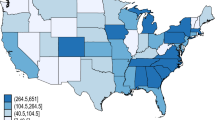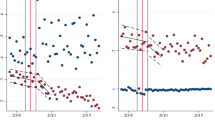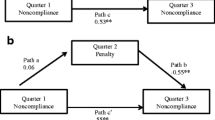Abstract
A two-way fixed effects Poisson model is used to investigate the impact of 43 EPA-sponsored pollution prevention (P2) practices on compliance and enforcement for a sample of facilities in the US manufacturing sector. I find that P2 adoption reduces environmental violations in three industries while increasing violations in two others. P2 adoption also spurs fewer enforcement actions in three industries. I further partition the P2 practices into three categories based on their approach to improve environmental performance. In doing so, I find that practices that involve changes in operating procedures—about a third of adopted P2 practices—such as instituting a self-inspection and monitoring program to discover spills or leak sources, improving maintenance scheduling and/or labeling procedures, are effective in reducing violations while practices that involve equipment or material changes are not. I also find that adopters of practices that require changes in either procedures or manufacturing equipment—about half of adopted practices—are rewarded with a more cooperative treatment of environmental infractions with fewer enforcement actions.
Similar content being viewed by others
References
Alberini A., Austin D. (1999) Strict liability as a deterrent in toxic waste management: Empirical evidence from accident and spill data. Journal of Environmental Economics & Management 38: 20–48
Anton W., Deltas G., Khanna M. (2004) Incentives for environmental self-regulation and implications for environmental performance. Journal of Environmental Economics & Management 48: 632–654
Arora S., Cason T. (1995) An experiment in voluntary environmental regulation: Participation in EPA’s 33/50 program. Journal of Environmental Economics & Management 28: 271–286
Arora S., Cason T. (1996) Why do firms volunteer to exceed environmental regulations? Understanding participation in EPA’s 33/50 program. Land Economics 72: 413–432
Arora S., Gangopadhyay S. (1995) Towards a theoretical model of voluntary over-compliance. Journal of Economic Behavior & Organization 28: 289–309
Bandyopadhyay, S., & Horrowitz, J. (2006). Do plants overcomply with water pollution regulations? The role of discharge variability. The B.E. Journal of Economic Analysis & Policy, 6.
Baron D. (2001) Private politics, corporate social responsibility, and integrated strategy. Journal of Economics & Management Strategy 10: 7–45
Burnett M. (1998) The pollution prevention act of 1990: A policy whose time has come or symbolic legislation?. Environmental Management 22: 213–224
Cameron C., Trivedi P. (1998) Regression analysis of count data. Cambridge University Press, Cambridge
Carrion-Flores, C., Innes, R., & Sam, A. G. (2009). Do voluntary pollution reduction programs (VPRs) spur innovation in environmental technology? Working paper, University of Florida.
Dasgupta S., Hettige H., Wheeler D. (2000) What improves environmental compliance? Evidence from Mexican industry. Journal of Environmental Economics and Management 39: 39–66
de Janvry A., Finan F., Sadoulet E., Vakis R. (2006) Can conditional cash transfer programs serve as safety nets in keeping children at school and from working when exposed to shocks. Journal of Development Economics 79: 349–373
Decker C. (2005) Do regulators respond to voluntary pollution control efforts? A count data analysis. Contemporary Economic Policy 23: 180–194
Deltas, G., Harrington, D., & Khanna, M. (2006). Green management and the nature of technical innovation. Working paper, Canadian Agricultural Economics Society (CAES) Meetings, Montreal, Quebec.
Duffalo, E. Empirical methods. http://web.mit.edu/14.771/www/emp_handout.pdf.
Gamper-Rabindran S. (2006) Did the EPA’s voluntary industrial toxics program reduce emissions?. Journal of Environmental Economics and Management 52: 391–410
Gray W., Deily M. (1996) Compliance and enforcement: Air pollution regulation in the U.S. steel industry. Journal of Environmental Economics & Management 31: 96–111
Harrington W. (1988) Enforcement leverage when penalties are restricted. Journal of Public Economics 37: 29–53
Hausman J., Hall B., Grilliches Z. (1984) Economic models for count data with an application to the patents-R&D relationship. Econometrica 52: 909–938
Helland E. (1998) The enforcement of pollution control laws: Inspections, violations, and self-reporting. Review of Economics & Statistics 80: 141–153
Henriques I., Sadorsky P. (1996) The determinants of an environmentally responsive firms: An empirical approach. Journal of Environmental Economics and Management 30: 381–395
Innes R., Sam A. (2008) Voluntary pollution reductions and the enforcement of environmental law: An empirical study of the 33/50 program. Journal of Law & Economics 51: 271–296
Khanna M., Damon L. (1999) EPA’s voluntary 33/50 program: Impact on toxic releases and economic performance of firms. Journal of Environmental Economics & Management 37: 1–25
Khanna, M., Deltas, G., & Harrington, D. (October, 2005). Adoption of pollution prevention techniques: The role of management systems and regulatory pressures. Working paper, Department of Agricultural and Consumer Economics, University of Illinois at Urbana-Champaign.
Magat W., Viscusi K. (1990) Effectiveness of the EPA’s regulatory enforcement: The case of industrial effluent standards. Journal of Law & Economics 33: 331–360
Maxwell J., Decker C. (2006) Voluntary environmental investment and regulatory responsiveness. Environmental and Resource Economics 33: 425–439
Maxwell J., Lyon T., Hackett S. (2000) Self-regulation and social welfare: The political economy of corporate environmentalism. Journal of Law & Economics 43: 583–617
McClelland J. D., Horowitz J. K. (1999) The costs of water pollution regulation in the pulp and paper industry. Land Economics 75: 220–232
National Pollution Prevention Round Table. Pollution prevention regulatory integration case studies. Available at http://www.p2.org/workgroup/regint/p2i2casestudies.pdf.
Nadeau L. (1997) EPA effectiveness at reducing the duration of plant-level noncompliance. Journal of Environmental Economics & Management 34: 54–78
Potoski M., Prakash A. (2005) Green clubs and voluntary governance: ISO 14001 and firms’ regulatory compliance. American Journal of Political Science 49: 235–248
Sam, A. G., Khanna, M., Innes R. (November 2009). Voluntary pollution reduction programs, environmental management, and environmental performance: An empirical study. Land Economics, forthcoming.
Sanyal P., Menon N. (2005) Labor disputes and the economics of firm geography: A study of domestic investment in India. Economic Development and Cultural Change 53: 825–854
Stafford S. (2002) The effect of punishment on firm compliance with hazardous waste regulations. Journal of Environmental Economics & Management 44: 290–308
Stafford S. (2003) Assessing the effectiveness of state regulation and enforcement of hazardous waste. Journal of Regulatory Economics 23: 27–41
Shimshack J., Ward M. (2005) Regulator reputation, enforcement, and environmental compliance. Journal of Environmental Economics and Management 50: 519–540
Terza J. (1998) Estimating count data models with endogenous switching: Sample selection and endogenous switching effects. Journal of Econometrics 84: 1239
Uchida T., Ferraro P. J. (2007) Voluntary development of environmental management systems: Motivations and regulatory implications. Journal of Regulatory Economics 32: 37–65
United States Environmental Protection Agency. (1998). Issuance of final supplemental, environmental projects policy. Memorandum available at http://www.epa.gov/compliance/resources/policies/civil/seps/fnlsup-hermn-mem.pdf.
Videras J., Alberini A. (2000) The appeal of voluntary environmental programs: Which firms participate and why. Contemporary Economic Policy 18: 449–461
Vidovic M., Khanna N. (2007) Can voluntary pollution prevention programs fulfill their promises? Further evidence from the 33/50 program. Journal of Environmental Economics and Management 53: 180–195
Welch E., Mazur A., Bretschneider S. (2000) Voluntary behavior by electric utilities: Levels of adoption and contribution of the climatic challenge program to the reduction of carbon dioxide. Journal of Policy Analysis and Management 19: 407–425
Author information
Authors and Affiliations
Corresponding author
Rights and permissions
About this article
Cite this article
Sam, A.G. Impact of government-sponsored pollution prevention practices on environmental compliance and enforcement: evidence from a sample of US manufacturing facilities. J Regul Econ 37, 266–286 (2010). https://doi.org/10.1007/s11149-009-9103-6
Received:
Accepted:
Published:
Issue Date:
DOI: https://doi.org/10.1007/s11149-009-9103-6




